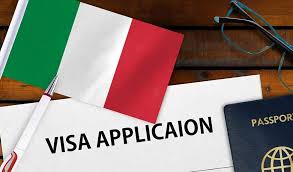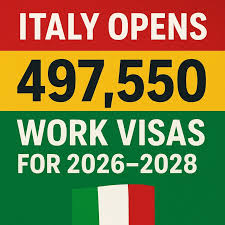The Italian government has officially approved an ambitious three-year plan to welcome nearly half a million foreign workers into its labour market between 2026 and 2028. The initiative, part of Italy’s renewed “Decreto Flussi” (Flow Decree), represents one of the largest legal migration schemes in Europe and is set to open new doors for non-EU citizens seeking employment in the country.
The approved quota of 497,550 work visas is aimed at addressing Italy’s growing labour shortages, particularly in critical sectors such as agriculture, construction, tourism, manufacturing, and domestic care. For job seekers in Africa, Asia, and other regions outside the European Union, this presents a major opportunity to work and live legally in one of Europe’s most developed economies.
Why Italy is Opening Nearly 500,000 Work Visas
Italy’s decision to expand its visa quota stems from multiple socio-economic challenges. The country is currently experiencing a serious demographic decline, with deaths outnumbering births and a rapidly ageing population reducing the available workforce. Many employers are struggling to fill vacancies in sectors like agriculture, hospitality, and construction, where manual and seasonal work is essential to the economy.
By introducing the 2026–2028 work visa plan, the Italian government hopes to balance two key priorities:
Filling labour gaps through legal migration channels.
Curbing irregular migration by providing clear, lawful pathways for foreign employment.
This move follows the success and lessons learnt from previous annual quotas, which were often exhausted within hours of the online portals opening due to high global demand. The new multi-year structure provides more predictability and planning time for both employers and prospective workers.
Visa Distribution and Quota Breakdown
According to Italy’s new labour decree, the total of 497,550 work permits will be distributed over three years:
164,850 visas in 2026
165,000 visas in 2027
167,700 visas in 2028
The distribution also distinguishes between different categories of work:
230,550 visas for non-seasonal employment and self-employment, including construction, manufacturing, and domestic care.
267,000 visas for seasonal employment, largely in agriculture and tourism.
This means both skilled and unskilled workers will have opportunities, though seasonal workers are expected to account for the majority of new arrivals.

Key Sectors Open to Foreign Workers
The new quota covers a wide range of economic sectors. Here’s a breakdown of the major areas where Italy is actively seeking foreign labour:
1. Agriculture and Farming
Agriculture continues to be one of Italy’s biggest employers of foreign workers. Many of the seasonal permits will target farm labourers, fruit pickers, vineyard workers, and other agricultural support staff. These jobs are typically tied to specific seasons but may lead to longer-term roles depending on performance and employer demand.
2. Construction and Skilled Trades
Italy’s infrastructure and housing projects are expanding, and the demand for construction workers, masons, electricians, plumbers, and general labourers has sharply increased. Non-seasonal visas are being allocated to this category to support ongoing development projects across the country.
3. Manufacturing and Industrial Work
Factories in Northern and Central Italy, particularly in regions like Lombardy, Emilia-Romagna, and Veneto, have reported shortages of machine operators, technicians, welders, and assembly-line workers. Foreign professionals with relevant technical skills will be prioritised.
4. Domestic Care and Home Support
With an ageing population, there’s high demand for carers, domestic helpers, and home support workers—known locally as colf e badanti. This sector receives a dedicated sub-quota each year due to Italy’s growing elderly care needs.
5. Tourism and Hospitality
Tourism remains a cornerstone of Italy’s economy. The 2026–2028 quota includes thousands of roles in hotels, restaurants, resorts, and travel-related services. Seasonal positions such as waiters, kitchen staff, and cleaners are highly sought-after by Italian employers, especially during the summer season.
Who Can Apply for the New Work Visas
The work visas are open to non-EU nationals, meaning individuals from countries outside the European Union, including Nigerians and other Africans. Applicants can qualify under two main categories:
Seasonal Employment: Temporary jobs in agriculture, hospitality, and tourism.
Non-Seasonal Employment or Self-Employment: Longer-term roles in construction, manufacturing, logistics, caregiving, and other skilled trades.
However, certain professionals, such as highly qualified managers, academic staff, or employees transferring within multinational companies, fall outside this quota system and apply through separate channels.
Application Process and Important Dates
The application system will follow the well-known “click day” model, where employers in Italy submit applications online for foreign workers during specific windows. However, the government has indicated efforts to streamline and simplify the process.
Here’s the expected timeline based on the 2026 rollout:
Pre-filing period: Autumn 2025 (for employers to prepare submissions).
Official “Click Days”: Early 2026, when applications can be filed online.
Visa Processing: Approved workers can begin entering Italy once their visas and work permits are issued.
Because the demand is extremely high, most quotas are filled within hours once the application window opens. Therefore, preparation and early coordination with potential Italian employers are essential.
How the Process Works
Find an Employer in Italy: Applicants cannot apply directly for most work visas. The Italian employer must apply for authorisation (called nulla osta) on the worker’s behalf.
Employer Submits Application: On the designated click day, the employer fills and submits the online application within the quota limits.
Approval from Authorities: Once the permit is approved, the employer sends the authorisation to the prospective worker.
Visa Application: The worker applies for a visa at the Italian embassy or consulate in their home country, attaching the necessary documents.
Travel and Residence Permit: After entering Italy, the worker must apply for a residence permit (permesso di soggiorno) within eight days.
This structured process ensures all migration remains legal and traceable under the government’s annual plan.
Regional Distribution and Labour Needs
Unlike previous years, Italy’s 2026–2028 plan introduces regional quotas, meaning different provinces will receive specific allocations based on their local labour demands. For instance, northern industrial regions such as Lombardy and Veneto may receive higher non-seasonal quotas, while southern agricultural regions may receive more seasonal allocations.
This approach is expected to improve efficiency, matching actual workforce demand with available migrant labour.
Challenges and Considerations
While the new plan is promising, it also comes with challenges that applicants should keep in mind:
High Competition: With nearly half a million slots spread across three years, demand will still far exceed supply.
Incomplete Conversions: In previous years, not all allocated slots were converted into actual jobs due to documentation delays or employer withdrawals.
Language Barriers: Basic Italian language proficiency improves chances of selection and integration.
Fraud and Scams: Applicants must be cautious of unverified agents or individuals promising guaranteed Italian jobs. Only registered Italian employers can sponsor applications under this program.
Pro Tips: How to Prepare Early
To increase your chances of securing a position under Italy’s 2026–2028 work visa program, follow these professional tips:
Start Early: Begin researching employers, especially in agriculture, construction, or domestic work. Establish contacts through verified channels.
Organise Your Documents: Ensure your passport is valid for at least one year. Prepare any certificates, trade credentials, or letters of experience relevant to your field.
Learn Basic Italian: Even beginner-level Italian gives you a significant advantage when dealing with employers or embassy interviews.
Understand the Visa You’re Applying For: Know whether you’re seeking a seasonal or non-seasonal visa and what your work duration will be.
Stay Updated on Announcements: Follow official Italian government updates to know when pre-filing and click-day windows will open.
Avoid Middlemen: Apply only through legitimate Italian employers. No private agents can issue or guarantee Italian visas.
Prepare Financially: Budget for application fees, travel, and living expenses during your first months in Italy.
Keep Copies of Everything: Maintain clear records of all applications, contracts, and communications.
Proper preparation not only improves your success rate but also helps you avoid exploitation or misinformation.
Italy’s plan to issue 497,550 work visas between 2026 and 2028 signals not just a labour reform, but a broader commitment to reshaping its economic future through structured, legal migration. For foreign workers—especially from Africa and Asia, this represents an unprecedented opportunity to enter Europe’s job market through legitimate channels.
Whether you’re a farm worker, construction artisan, caregiver, or hospitality professional, Italy is opening its doors to skilled and dedicated hands ready to contribute to its economy.
The time to prepare is now. Begin gathering your documents, identifying your target sector, and researching legitimate Italian employers. When the official application window opens in 2025, be ready to act fast.
To apply and access official details, visit Italy’s official government immigration website and stay alert for the 2026–2028 Decreto Flussi announcements.
Your journey to working legally in Italy could begin with a single, well-prepared application.
- Click Here To Read More
